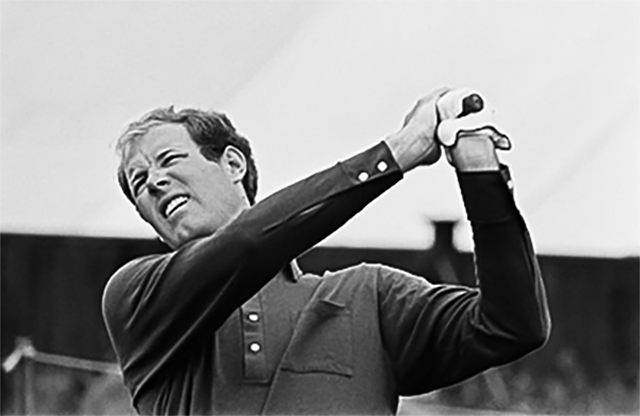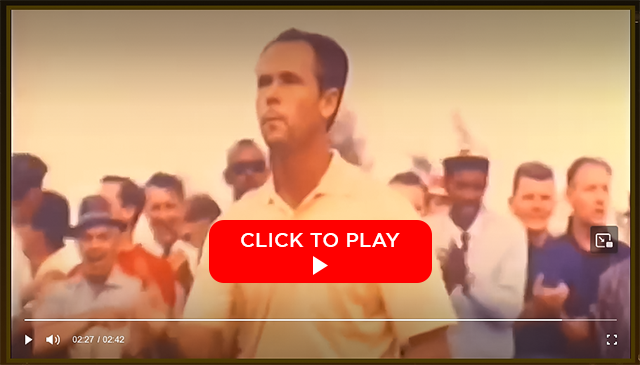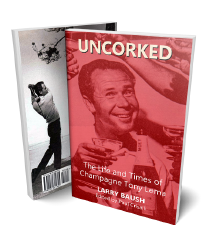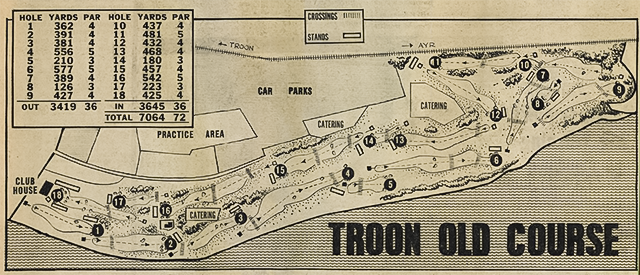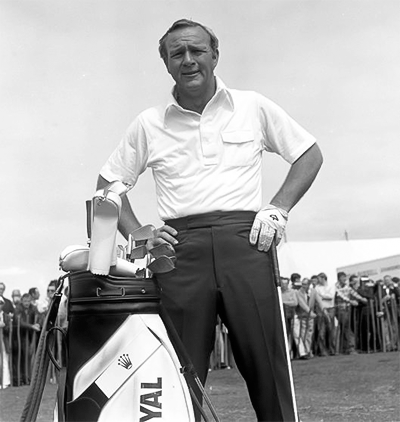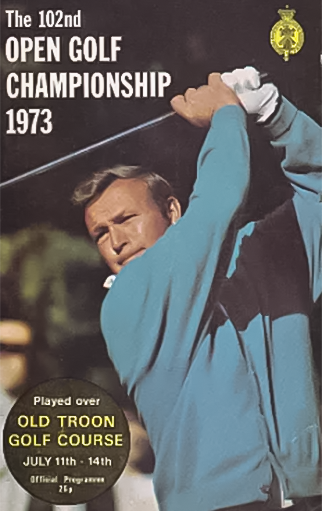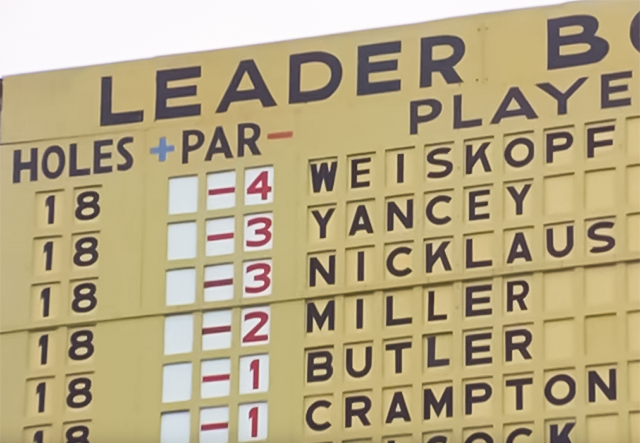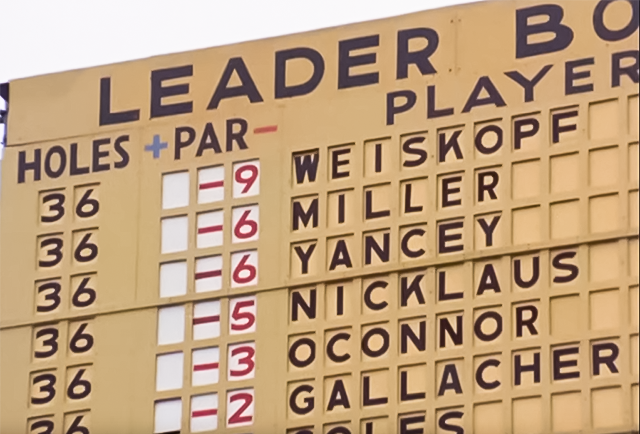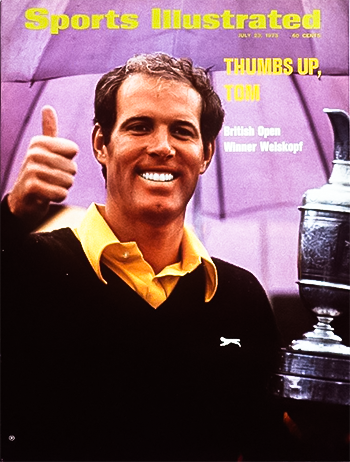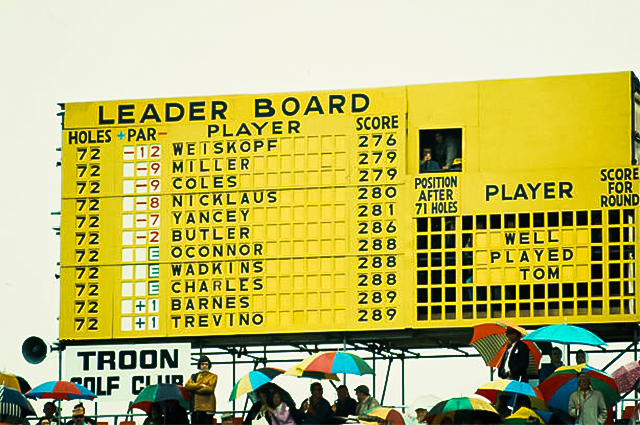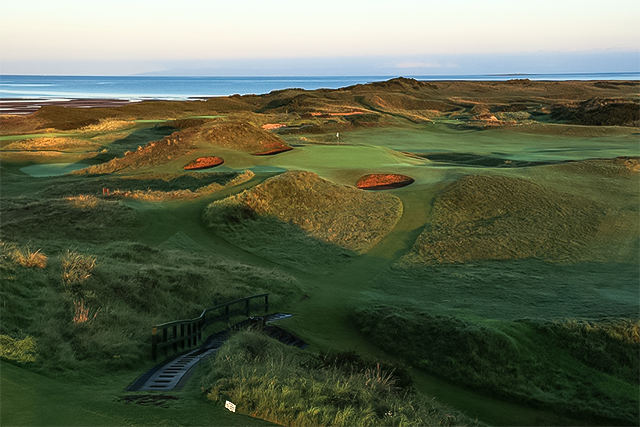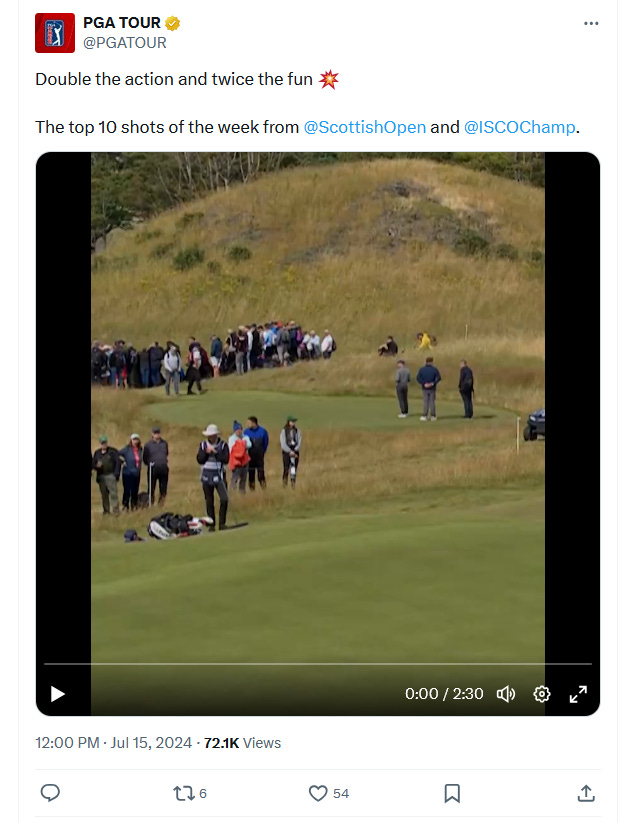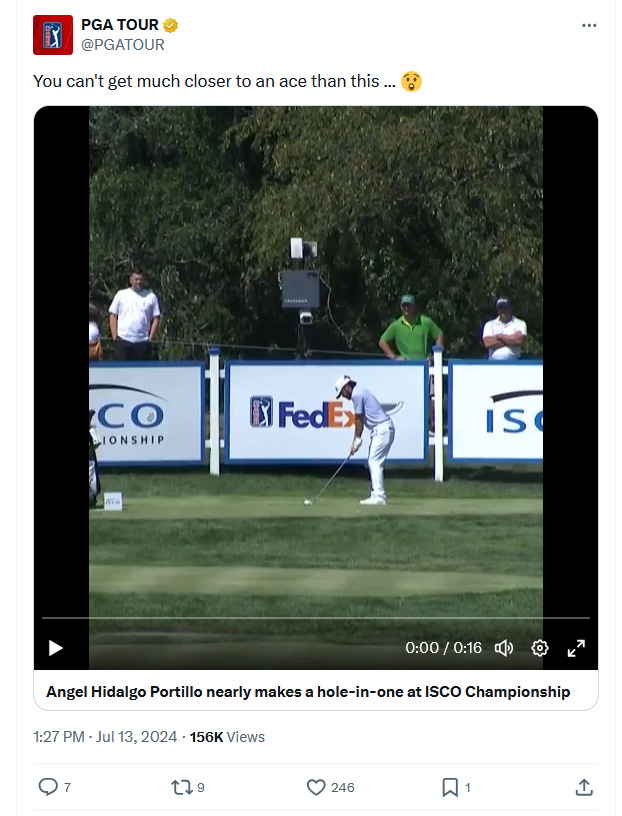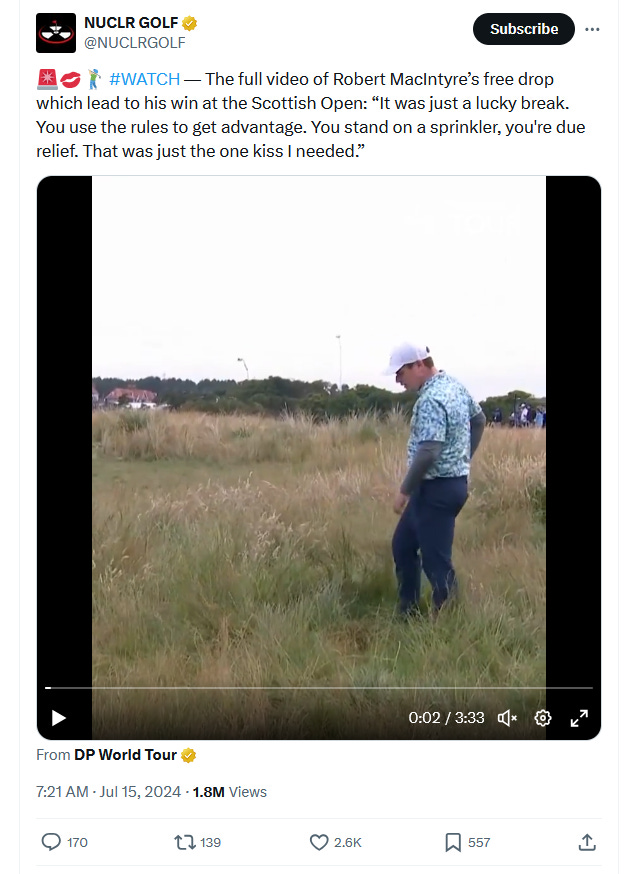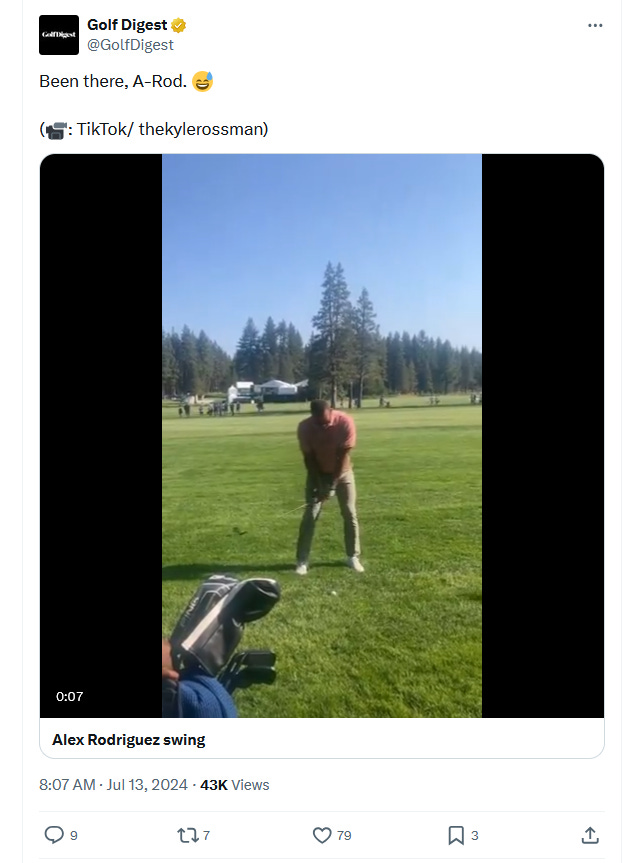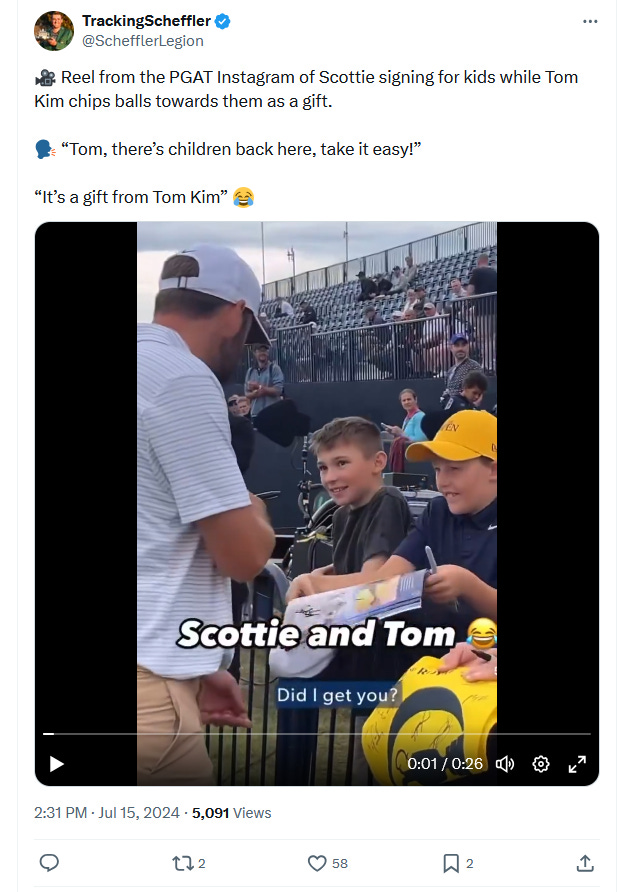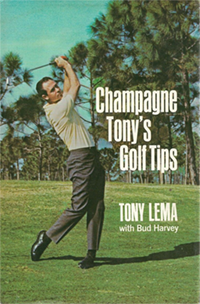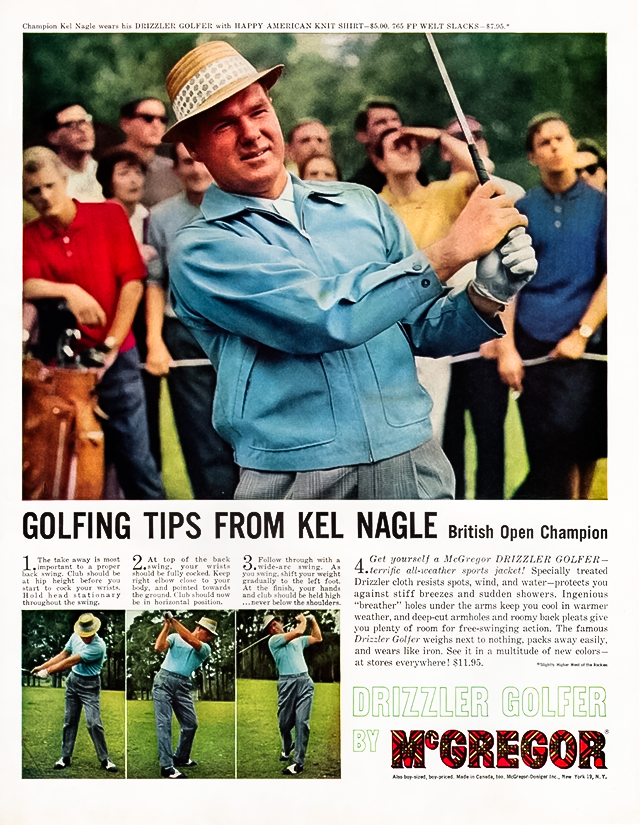It’s Open Championship Week! Explore the history of the 1973 Open Championship where Tom Weiskopf won his only major championship in very wet conditions at Troon Golf Club (Troon was awarded the Royal Charter in 1978). Scroll down to read. This year’s Open Championship marks the 60th year anniversary of Tony Lema capturing the Claret Jug at The Old Course in St. Andrews.
We’ve written about the 1967 Open Championship won by Roberto DeVicenzo HERE, and the 1960 event, won by Arnold Palmer, that gave birth to the modern grand slam HERE, and of course, the 1964 Open Championship in my biography of Tony Lema which can order HERE.
We have some exciting news about the progress being made on the documentary movie based on my book about Tony Lema. We’ll be updating the news in upcoming editions of Tour Backspin. We now have a website that features a trailer. Check it out by clicking on the clip below.
What a finish in the Scottish Open with Robert MacIntyre making three straight threes down the stretch to win in his own country. His putt on the final hole just crawled over the lip and his countrymen responded with an explosive roar. Harry Hall chipped in on the third playoff hole to win the ISCO Championship, his first PGA TOUR victory. Scroll down for the tournament wrap-ups, a few thoughts from me, and the Clips You Might Have Missed.
We want to hear your prediction for The Open Championship score in the Tour Backspin Poll, and this week’s Music Clip features Elton John doing a live (in Scotland!) solo version of “Saturday Night’s Alright (For Fighting). Scroll down to listen. We highlight the sweet swing of Tom Weiskopf, and Tony Lema talks about the chip-and-run shot he used at St. Andrews in the 1964 Open Championship in the Swing Like a Pro feature. This week’s WHAT HOLE IS IT? Presented by Rota Golf is pretty easy so give it a shot and you may just win a golf swag prize pack. Rota Golf has a cool way to map out your bucket list journey of playing the top 100 courses in the U.S. We’ve got some links for you in the Check it Out section and an ad with a British Open flair is featured in this week’s Vintage Ad. Scroll down to view.
The latest episode of The Tour Backspin Show has dropped on YouTube for all subscribers. Our annual paid subscribers have had access to this podcast that features Lee Trevino receiving the Legacy Award from the Robert Trent Jones Society, and discussing his illustrious career. Early access to The Tour Backspin Show is one of the benefits of being a paid subscriber to Tour Backspin. Feel free to share this with your golf buddies.
We understand if a premium subscription isn’t in the budget, and we’re happy to have you here however you’ve arrived. You can sign up for a free subscription so you’ll never miss the newsletter. It will arrive in your inbox every Thursday. Paid subscribers help fund the work we do here at Tour Backspin.
In last week’s Tour Backspin Poll we asked, Who ya got in The Open Championship? Rory McIlroy got the most picks with 38% of the vote while Bryson DeChambeau received 25% of the votes, Scottie Sheffler got 13%, and the field received 25%
This week let us know what you think the winning score will be at Royal Troon. Will the score be over, or under, 274? Show us your best prognosticator skills.
Tour Backspin Poll
Do you know what happened today in golf history? Or which famous golfer has a birthday today? Me, neither. But I do know where to go to find out. Check out the Your Golfer’s Almanac podcast. Host Michael Duranko celebrates birthdays, milestones, and other accomplishments that occurred on this day in golf history. Listen HERE.
We’re playing The Open Championship Trivia in this week’s Tour Backspin Quiz. Scroll down to play.
Did you miss a previous newsletter? You can view it HERE. Help us grow Tour Backspin! Please forward this email to a friend. Was this newsletter forwarded to you? You can sign up HERE.
Okay, we're on the tee, let's get going.
Enjoy!
Larry Baush
Tom Weiskopf Goes Wire-to-Wire in Wet Conditions to Capture Claret Jug

Frankie Taylor of The Sunday People out of London, landed an interview with Lee Trevino’s English business manager, Derrick Pillage. Taylor was looking for Pillage to handicap the field for the 102nd playing of The Open Championship at Troon Golf Club in Troon, South Ayrshire, Scotland. Troon would play at 7,064-yards at a par of 72. The interview was published in the paper’s Sunday, July 8th, 1973, edition, three days before the opening tee shot would be struck. The Open Championship during this era ran from Wednesday to Saturday.
Trevino was looking for what he called a “Mexican Hat Trick,” his third consecutive Open Championship, having won in 1971 at Royal Birkdale and again the next year at Muirfield.
Pillage began by predicting that Tony Jacklin had no chance to win at Troon.
“I’ll never consider myself a great player until I win a major championship.”
“Trevino has listed the men he feels he will need to beat for his third Open on the trot and Jacklin isn’t even included,” Pillage told Taylor. “I rate him as my fifth favorite purely because he is the greatest small ball player in the world.”
Pillage then listed his five top players that readers should consider before placing any bets in the legal sports books in the United Kingdom. He picked his man, Trevino, at 6-1 odds, as the best choice to win and followed with Nicklaus who was at 7-2 odds. Next, he predicted Tom Weiskopf at 10-1 odds. Weiskopf was entering the Open Championship on a hot streak having won three tournaments so far for the year, but he put a major emphasis on winning a major championship.
“I’ll never consider myself a great player until I win a major championship,” Weiskopf said before the start of the tournament at Troon.
Taylor’s picked for the next two spots in his top five were Peter Oosterhuis at 20-1, and Tony Jacklin at 16-1.
Arnold Palmer arrived in Troon on Sunday to begin his preparations for the championship. He won at Troon in 1962 with a record setting total of 276, a score that still stood as the lowest total in Open Championship history. After a few hours of sleep, he was in a lively mood and looked forward to seeing any changes to the course that had been made since 1962. One change that had been made was on the 12th hole which had been lengthened.
“It hasn’t changed much,” Palmer said after his first look at the course. “Even the extended 12th is not really very different.”
With gambling on sports being legal in the U.K., every newspaper had a tote sheet on Monday or Tuesday handicapping the field. While the old guard, led by Lee Trevino Jack Nicklaus, Arnold Palmer, and Tony Jacklin, were given their due, there was also a lot of excitement generated by the new breed of stars. Johnny Miller, winner of the U.S. Open in June at Oakmont after a final round 63, was a favorite pick as was Tom Weiskopf, and Lanny Wadkins. Doug Sanders, Bruce Crampton, who just became the first foreigner to win $1 million on the PGA TOUR, and Dave Hill also garnered attention from the handicappers.
The players carrying the torch for the U.K, in addition to Jacklin included Peter Oosterhuis, Neil Coles, Christy O’Conner and Brian Barnes. Five-time Open champion Peter Thomson, Masters winner Tommy Aaron, and Bob Charles were also given a good chance to win money for the punters.
“That’s enough. I’m playing well, and I don’t want to get over-tired. My legs feel good, and I don’t want to tire them.
Leslie King, known as “The Golf Doctor,” in the Daily Mirror of London, wrote in his handicapping feature about Tom Weiskopf, whom he chose as his fourth pick behind Trevino, Nicklaus, and Jacklin.
Without doubt, Weiskopf has the finest swing of anybody playing in the championship—just about the most perfect I have seen. It is beautifully compact with a perfect line from the top of the backswing down into the ball . . . a champion’s swing. The only thing that prevents me from tipping him as a winner is his short game. When I watched him, he sank very few putts of consequence and rarely laid his chip shots dead. If you could amalgamate his long game with the superb short game of someone like New Zealand’s Bob Charles, you would then have a golfer who could win title after title.
Johnny Miller was the last big-name player to arrive in Troon flying in on Monday and played an 18-hole practice round. Although he planned on playing 36 holes of practice on Tuesday, he was satisfied with his preparations after only 18 holes.
“That’s enough,” he said after his round. “I’m playing well, and I don’t want to get over-tired. My legs feel good, and I don’t want to tire them. If I can get my driver working, I could have a real good tournament. I’m hitting my irons like I did at Oakmont, when I won the U.S. title.”
There was precedent for arriving late and then winning the Open. Tony Lema arrived for the 1964 Open Championship at The Old Course in St. Andrews late and only had 27 holes of preparation before he won the Claret Jug. Trevino arrived late at both Opens he won in 1971 and 1972.
“These clubs are what I call windcheaters. I can hit the ball low with them under the wind.”
Lee Trevino revealed to the press that he intended to play the championship with borrowed clubs. He felt that his business manager’s clubs matched the windy conditions better than his own clubs. He went about getting used to the clubs that belonged to Derrick Pillage by hitting 400 practice balls with the set.
“These clubs are what I call windcheaters,” Trevino explained. “I can hit the ball low with them under the wind. And that’s going to be vital playing against the wind on the second nine holes of this course.”
Bob Charles predicted that the early wave of starters on Wednesday would have an advantage.
“The guys who get early starts tomorrow are going to have a tremendous advantage,” he said. “The greens look like all hell has been let loose on them.”
The many practice rounds that the 153 competitors had played influenced the greens leaving them bumpy. South African Terry Westbrook agreed with Charles on the shape of the greens.
“It’s not the same golf course it was when I came here last week,” he noted to Bob Rodney of the Daily Mirror. “The greens were super then.”
The early starters included Palmer, Nicklaus, Bruce Devlin, Lee Trevino, and Bert Yancey. Miller’s tee time was 12:54 and he was followed by Doug Sanders at 2:33, and Weiskopf at 3:18.
While the remote location of Troon would keep attendance figures down, the BBC planned on the most extensive television coverage to date. There were 25 hours of coverage planned beginning at 10:55 am on Wednesday. The coverage would include action from 11 holes including every stroke at the dreaded 8th hole known as “Postage Stamp” because of the tiny green on the 126-yard, par-3.
Officials announced that players would go off in threesomes instead of twosomes in an effort to get rounds finished faster.
DAY ONE
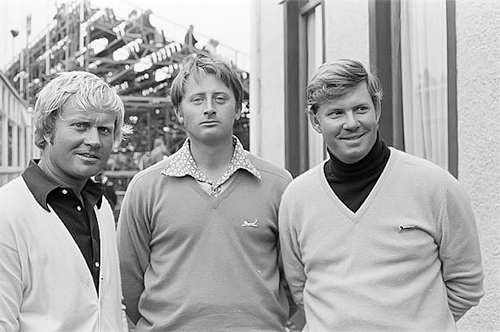
The players with early tee times started their rounds under menacing clouds that hung low over Arran, an island off the west coast of Scotland and the largest island in the Firth of Clyde. The wind, blowing at 10 to 15 miles per hour, was off the northwest which kept the rain away.
Bert Yancey took advantage of the winds, which made the outward nine holes play downwind, to fashion a 30 with six birdies. But, as many would learn in the first round, it was the inward nine holes, played into the teeth of the wind, that would provide the challenge. Yancey quickly experienced the difficulty when he double bogeyed the 11th hole, known as “The Railway” as a railway runs along the right, close to the green.
“I should have taken a free drop. But I was worried about dropping into a bad lie.”
He drove into a “burrowing animals’ area” that was deemed to be ground under repair and was entitled to a free drop. After inspecting the area where he would have to drop, he realized the drop would most likely result in a lie worse than the one he had in the ground under repair and elected to play his ball without utilizing the free drop.
“I should have taken a free drop,” he admitted after the round. “But I was worried about dropping into a bad lie.”
He played the shot, with a train roaring past on the railway, with a 3-iron and pulled it into heavy gorse resulting in an unplayable lie and wound up making a seven. Both of his playing partners, Nicklaus and Brian Barnes, were surprised that Yancey did not wait to let the train pass.
Yancey came home with a 39 for a round of 69. Nicklaus did not have his best game and three-putted the 3rd and 11th holes. He was able to keep himself in the tournament aided by an eagle at the 6th hole and a holed-out bunker shot on the 16th hole for birdie. Nicklaus went out in 33 and came home, battling against the wind, with a 36 to match Yancey’s score.
“It’s one of the best ball-striking rounds I’ve ever played. If I keep on like this for four rounds, I’ll win.”
The winds moderated as Weiskopf made the turn meaning that he enjoyed the advantage of playing the first nine holes downwind while it was still blowing, and then enjoyed calmer conditions on the back nine than the early starters, who had to battle a headwind. He took advantage of the conditions to shoot 35 on the back nine, one of only three players to break par on the inward nine. With his 33 on the front nine, Weiskopf held the lead at 68.
Miller came in with a 70 and was pleased with his round.
“It’s one of the best ball-striking rounds I’ve ever played,” he said to Bob Rodney of the Daily Mirror. “If I keep on like this for four rounds, I’ll win.”
Weiskopf did not have lofty expectations for his first round.
“I was discouraged by my late starting time, my poor practice rounds—and the course,” he said. "It’s a funny one for me. I get into situations where I can’t figure out which is the right shot to play.”
“Finally this old fellow said, ‘I have to go now, but you keep going.’ I really appreciated him.”
He credited a veteran Scottish fan for turning his attitude around.
“I didn’t feel anything was going to happen today,” he told Rodney. “And then I missed that little putt on the first green. But this old fellow spoke to me. He said not to worry—I would get them today. Then I hit a drive and wedge to the second green and made a putt from 15 feet for a birdie. At the next hole, I sank a tricky one, 18 feet, for another birdie three. And this old guy was there again, smiling. Finally this old fellow said, ‘I have to go now, but you keep going.’ I really appreciated him.”
Three Britons, Neil Coles, Peter Butler, and Peter Wilcock were at 71 while Jacklin could do no better than a 75, the same score as Trevino, and Peter Oosterhuis came in with a disastrous 80.
Gene Sarazen, at the age of 71, thrilled fans, both on site and watching on television when he aced the short par-3 8th hole known as “Postage Stamp” (see the Bonus Story).
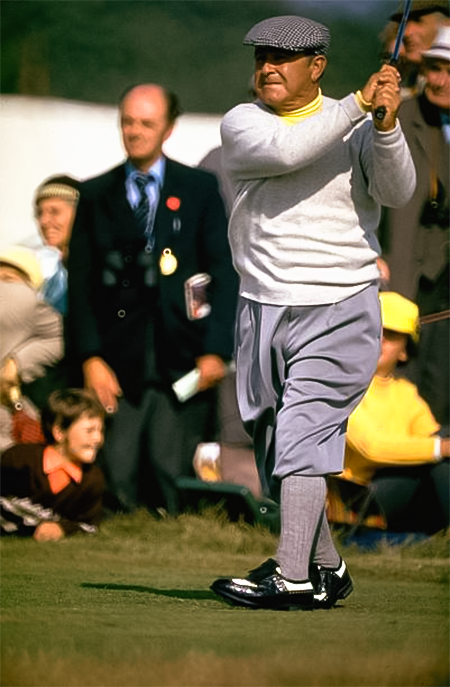
Play was held up several times as players, caddies, and spectators covered their ears to block out the roar of planes taking off from nearby Prestwick Airport, just a mile from the course. Open officials explained that arrangements had been made to have the planes take off and land away from the course, but the winds out of the northwest forced a change in plans.
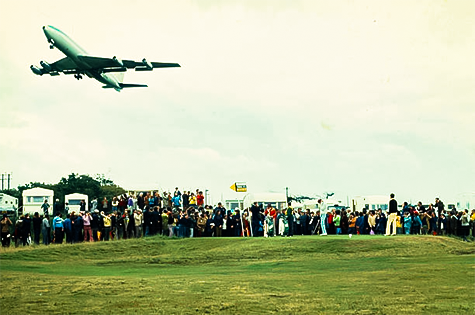
“The wind in its present direction has made this impossible—it would be too dangerous,” an official said.
DAY TWO
Gene Sarazen followed up his ace at the 8th hole on Wednesday by holing out from a bunker for a deuce at the same hole on Friday. Unfortunately, Sarazen would miss qualifying for the third round, but he did play the short par-3 in three strokes over two rounds.
“That’s about as good as I can play.”
Tom Weiskopf was pleased with his second round, a 67 shot in good weather for the first seven holes before the wind began to blow. Then rain fell starting at the 15th hole. Two factors made the weather conditions easier than in the first round. The first was that the wind was blowing more from the west than the northwest, so it was mainly a crosswind, and the second was that the rain that fell was light rain that did not have much effect on the players.
“That’s about as good as I can play,” Weiskopf said after his round.
He recorded four of his five birdies by the time he got to the 15th hole and was able to add one more after the rain began falling. He secured pars on the remaining holes with tap-in putts, except for the 9th hole where he made a 12-foot putt to save his par.
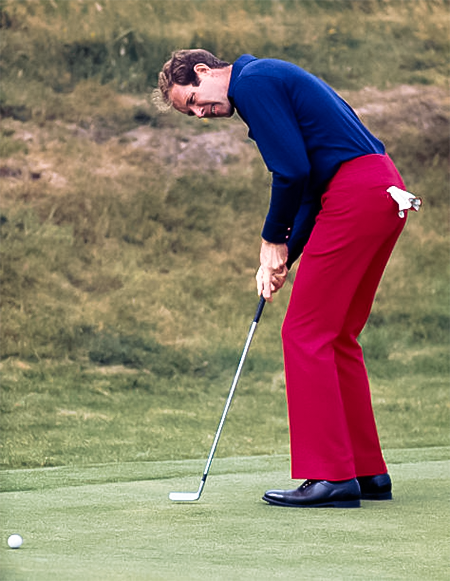
“I really felt good about that one,” Weiskopf said about the putt on the 9th. “My tee shot was only moderate and my second shot with a wedge was a little less than that. My chip back wasn’t good either and the putt was a real nasty one. I felt when I holed it that I could really go from there.”
Johnny Miller started his second round slowly getting pars on the first six holes, a stretch that players expect to play in two-under-par. Miller sank a five-foot putt for par, after a long bunker shot, at the 5th hole that was an important save for him. He secured his first birdie at the 7th hole and added birdies at the 10th and the 11th, both difficult holes. He reached the par-5 11th hole in two but missed his eagle putt. He then added a final birdie at the 16th hole. It all added up to a 68 and a two-day total of 138, three shots behind Weiskopf.
“I don’t know what it is, but there is something wrong technically.”
Bert Yancey drove the ball well all day but admitted to reporters that his irons “were not quite right.” He shot a 34 on the front and came back with a 35 for a 69 and was tied with Miller at 138.
Nicklaus was not happy with his play despite posting a 70 in the second-round. He felt he played too many bad shots, especially on the back nine.
“I don’t know what it is, but there is something wrong technically,” Nicklaus said after his round.
His 70 put him at 139, still within sight of Weiskopf.
Christy O’Conner got off to a hot start with a birdie at the 2nd hole and an eagle at the 3rd where he hit a 10-iron into the hole. He made the turn with a 33 and then sank a long putt for birdie at the 10th hole. His only dropped shot came at the 13th hole where he three-putted. He finished with a 68 that put him on 141.
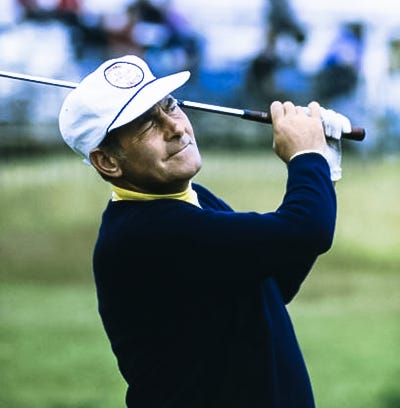
Tony Jacklin recorded a 73 that included a two-shot penalty after an improper drop from a burrowing animal area. He sat at 148, tied with Lee Trevino who also had a 73 in the second round.
DAY THREE
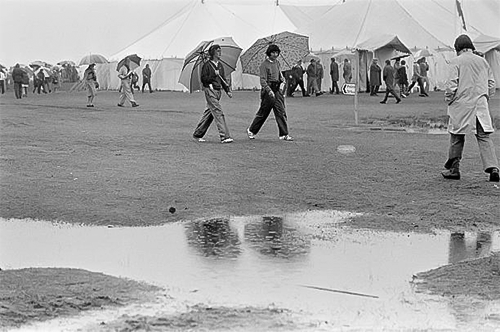
Friday’s third round was played in damp and miserable conditions. Michael Williams of the Daily Telegraph reported that “the rain was never exactly heavy, but the skies closed in soon after lunch and the leaders had to play a full round in a sort of relentlessly hard drizzle.”
The narrator of the R&A highlight film said, “It’s destined to be the sort of day that the man in The Times wrote on which whisky must have been invented.”
Spectators sought whatever shelter they could find while the players employed umbrellas and waterproof suits. Officials worried, as they watched casual water collect, that play might have to be halted. Even with the rain, the scoring conditions were good until towards the end of the round when the wind picked up.
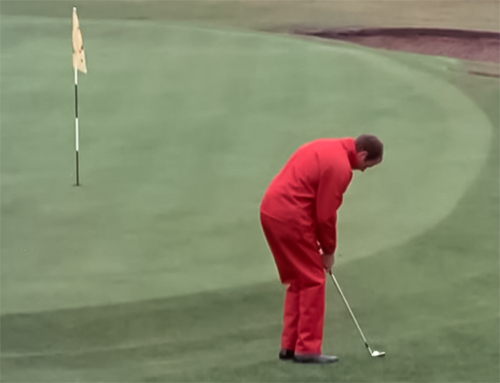
Weiskopf arrived at the first tee under a green and white umbrella wearing bright red raingear while Johnny Miller wore a black rainsuit. The two players immediately set forth on an epic battle. Weiskopf dropped shots at the 1st and 3rd holes while Miller made a three at the 3rd to grab a share of the lead.
This was the first chink in the armor of Weiskopf all week, but he regained the lead after making a long putt for birdie on the long par-3, 5th hole. Miller immediately answered with a birdie of his own on the 6th hole. Both players made long birdie putts at the 7th hole, and then again on “Postage Stamp,” the par-3, 8th hole.
“You don’t play golf and fall in love with many sixes, but I love that one.”
Miller played first on the 8th hole and hit his tee shot to seven feet and then Weiskopf stepped up and matched Miller’s shot finishing one inch closer to the hole. Both players were at 10-under and Yancey, playing in front of them, was at 8-under.
When Weiskopf duck-hooked his drive off the 9th tee it looked like his magic for the week was subsiding. His drive found an unplayable lie in waist-high whins, and he was lucky to find his ball. He walked back 125-yards to take his penalty drop, back by the 8th tee. He could not see the 9th green which was about 250-yards away. He blistered a 1-iron to in front of the green, pitched on, and then two-putted for a six.
“You don’t play golf and fall in love with many sixes, but I love that one,” Weiskopf said after his round.
The two players had pulled away from the rest of the field and it was a head-on-head battle through the back nine. Weiskopf saved pars from four bunkers on his way in, and it was Miller who faded bogeying two of the last four holes with putts that lipped out. When his ten-foot putt lipped out at the 18th hole, Miller ripped the knitted hat off his head and threw it to the ground in disbelief.
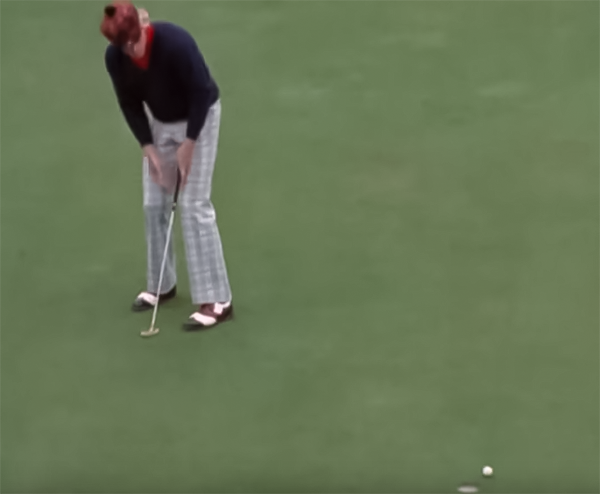
Weiskopf wound up with a round of 71 for a total of 206 while Miller managed to shoot a 69 for a total of 207.
“In many ways, a round like that gives you the most satisfaction in golf,” Weiskopf said after his up-and-down round. “Johnny was playing great, and I was fighting for my life, and I held on. I just kept telling myself I could do it.”
Yancey bogeyed the first hole but came back with three birdies to make the turn in 34. He birdied the 10th hole but dropped four shots over the last eight holes to shoot a 73 and was at 211. Barnes, with a third round 70, and Coles, also with a third round 70, sat at 213. Lanny Wadkins also shot 70 in the third round and was at 214, while Christy O’Conner, with a third round 74, was tied with Jack Nicklaus who skied to a 76.
After his round, Weiskopf spent over an hour on the practice tee working on his alignment as he found he was lining up too far left of the target. After working out the flaw, he retired for the evening to eat dinner and then to try to sleep on his one-stroke lead.
DAY FOUR
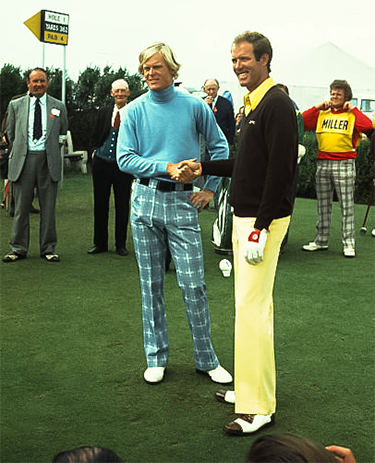
“Keep you head and swing it slowly.”
On Saturday morning, before the final round of The Open Championship, Tom Weiskopf was eating his breakfast when the phone rang. On the other end of the line was Tony Jacklin who had a little advice to impart.
“Keep you head and swing it slowly,” Jacklin advised Weiskopf. This was payback by Jacklin who had opened his locker before the final round of the 1969 U.S. Open and found a note from Weiskopf advising him to “stay cool.”
As the leaders departed the Marine Troon Hotel, the skies were bright and when they teed off to begin the final round, the raingear was stuffed away inside of their golf bags. After three holes, the rain returned, and the umbrellas came out.
“I said to myself, ‘You’ve made a mistake Tom, now forget about it and swing easy.’ ”
Weiskopf played the first nine holes with precision, scoring two birdies to make the turn in 34. He seemed to be cruising along and then he came to the difficult 13th hole, a 468-yard, par 4. He hit his second shot into heather and could only hack out and took a bogey five. Here is where the note from Jacklin paid a dividend to Weiskopf.
“I remembered Tony’s words when I took my only bogey in the last round,” Weiskopf told Bill Clark of the Sunday Mirror. “I said to myself, ‘You’ve made a mistake Tom, now forget about it and swing easy.’ ”
Weiskopf then birdied the 15th hole. He was making his putts, some of them quite lengthy, while Miller was not. Miller’s body language was beginning to turn negative. After Weiskopf made his birdie at the 15th hole, Miller missed a very short putt that would have kept him within two strokes of Weiskopf. It was all but over at this point. When Weiskopf hit the final green in regulation he was assured of his first major championship.
Weiskopf finished with a round of 70 and a four-round total of 276 equaling The Open Championship scoring record set by Arnold Palmer in 1962. Miller finished with a round of 72 for a total of 279, tied with Neil Coles who stormed to a final round of 66 to finish as the low Brit.
Jack Nicklaus also had a stellar final round setting a new course record with a 65 that moved him up to 280.
Weiskopf won £5,500 ($14,300) for his victory while Miller and Coles won £3,625 ($9,425) each. Nicklaus won £2,750 ($7,150). Bert Yancey had a final round of 70 for 281 and took home £2,450 ($6,370).
After accepting the Claret Jug, Weiskopf took a page out of the Tony Lema playbook and had a case of champagne delivered to Open officials, and another case delivered to the press.
The result of the 1973 Open Championship was not a “Mexican hat trick” for Lee Trevino, but it instead was the first, and only, major championship for Tom Weiskopf. He won his major during a wet, chilly, and windy week at one of the toughest courses on the Open Championship rota—Troon Golf Club. He won it wire-to-wire, the only Champion Golfer of the Year to do that at Troon, and he was one of only seven to hold the outright lead over four rounds in The Open Championship.
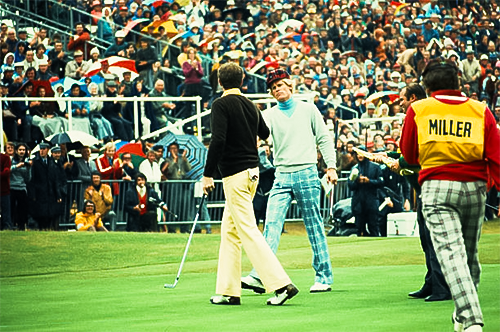
BONUS STORY
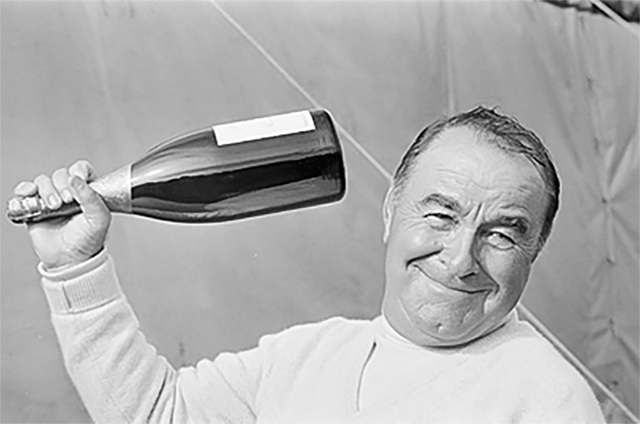
It was 71-year-old Gene Sarazen who provided the biggest dose of excitement in the first round. Playing with two other former Open champions, Fred Daly and Max Faulkner, he came to the 8th hole, known as “Postage Stamp.” After pulling a 5-iron from his bag, he turned to the steward who was keeping score for the group and said, “I don’t think I’ll need three shots for this one.”
He then lofted his 5-iron shot that bounced on the front of the green and began rolling towards the hole. It was met by polite applause as it landed, which grew in intensity as it rolled closer and closer to the hole. The ball rolled on and on before dropping into the hole as the crowd erupted and Sarazen broke into a little jig.
“I think I’ll keep this one.”
The old pro almost trotted down the 126-yards to the green and brought another roar from the crowd as he doffed his cap and put it over the hole. He then tucked the ball carefully into his hip pocket.
“I think I’ll keep this one,” he said.
When he was informed that the shot was captured on film he was delighted saying, “It’s great. When I go up to see Walter Hagen and Bobby Jones in heaven, I’ll take a copy with me. Then they’ll have to believe me.”
Gene Sarazen passed away on May 13th, 1999, at 95 years old and I’m sure he took this clip with him to show Hagen and Jones.
What Hole is It? powered by Rota Golf. Doesn’t your bucket list journey deserve one of these?
WHAT HOLE IS IT?
Are you on the leader board?
Congratulations to Glenn Blue, who correctly identified #13 at The Renaissance Club in North Berwick, Scotland, in last week’s WHAT HOLE IS IT? contest. Glen beat out three other correct answers in the random drawing. We’re sending a prize pack of golf swag, including new stickers, to Glenn. Submit your answer for this week and get yourself into the race for the Herbert C. Leeds Trophy, our new perpetual trophy for the annual winner.
PGA TOUR Wrap-Up | Genesis Scottish Open
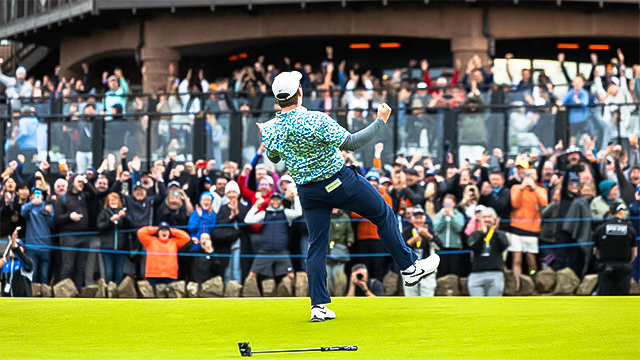
Robert MacIntyre received a ruling on the 16th hole at The Renaissance Club when he found he was standing on a sprinkler head in deep rough. He was granted a free drop which resulted in a much better lie. He took advantage and hit his second shot onto the green and made the putt for an eagle three. He followed with a par three on the 17th, and a birdie three on the 18th to win the Genesis Scottish Open in his home country.
It was an electrifying finish and the crowd went crazy after his putt on 18 rolled slowly across the green, hung on the lip for an instant before dripping into the hole.
MacIntyre spoke about his good fortune when it came to the drop.
“I’m shouting and I’m swearing when I’m getting up to the ball because I know that that’s my chance to really make birdie coming in. I got over the ball, looked at it, thinking, I’m in a bit of trouble here. Might manage to move it maybe a hundred yards,” he explained. “Look, I got a bit of luck on 16 and you need a bit of luck to win golf tournaments. I couldn’t believe when I heard a spring under my foot where my spike is at and I’m like no way. It was covered, and I thought, I got lucky; it was meant to be.”
MacIntyre warned that he might have “some alcohol still in the system” at The Open Championship this week.
Meanwhile, back in the states, Harry Hall chipped in on the third playoff hole to win the ISCO Championship. Read more, and watch the chip it HERE.
Watch the top ten shots from both events here:
Read a recap of the tournament by the PGA TOUR HERE.
Clips You Might Have Missed
So close.
Watch Robert MacIntyre’s free drop.
And the winning putt.
YIKES! FOUL BALL!
Tom Kim and Scottie Scheffeler having some fun at The Open Championship.
Tour Backspin Quiz | The Open Championship Trivia
How many players have won The Open Championship wire-to-wire? Who are they? What years did they do it?
Scroll down for answer
Swing Like a Pro
The beautiful swing of Tom Weiskopf hitting driver in 1973.
Audio excerpts from the book Champagne Tony’s Golf Tips by Tony Lema with Bud Harvey.
(Click on player and scroll down when page opens)
But there's a time and place for everything, and I'm convinced that the American golfer works the wedge to death. I was reminded of this during the British Open championship at St Andrews. That magnificent links is one of the most intriguing tests of golf I've ever encountered, and nothing at all like the typical American parkland course. For reasons that are both economic and traditional, our British cousins don't go in for heavily watered greens and fairways. This means the wedge shot, the darling of American pro and amateur alike, is relatively ineffective over there. You can throw a shot up on those greens at St Andrews with lots of bite on it, but when the putting surface is like granite it doesn't offer anything to bite. On those fast fairways and rock-hard greens I choke up on those seven and eight irons and let the ball run up there.
*AI generated voice
Blind Shot
Click for something fun. 👀
Kyle Porter discusses the choice of Keegan Bradley as the Ryder Cup captain at CBSsports.com.
Tour Backspin Music Clip
What could be a better Tour Backspin Music Clip than Elton John performing Saturday Night’s Alright (For Fighting) solo in Scotland? From 1976.
Uncorked, The Life and Times of Champagne Tony Lema tells the story of one of the tour’s biggest stars in the mid-1960s. A fascinating glimpse into the traveling caravan that was the PGA TOUR during an era where the fields were full of “Mad Men” era personalities. From a hardscrabble youth spent on the “wrong side of the tracks” in the Oakland suburb of San Leandro, to the temptations of Elko, Nevada, to the bright lights of the PGA TOUR, Uncorked tells a story of determination, redemption and, above all else, a love story that documents how Betty, Tony’s new wife, provided the direction and motivation for him to become a top star. Order on Amazon.
Tour Backspin Quiz Answer:
Seven players have won The Open Championship wire-to-wire. Ted Ray in 1912, Bobby Jones in 1927, Gene Sarazen in 1932, Henry Cotton in 1934, Tom Weiskopf in 1973, Tiger Woods in 2005, and Rory McIlroy in 2014.
Thank you for reading this far, I know your time is valuable and choosing to spend some of it on what I’ve created is gratifying. If you want to help support the work we’re doing, please consider upgrading. It’s just $36 a year and you’ll be helping to tell the stories from one of golf’s golden ages.
Vintage Ad
Final Thoughts
Tough choice for the Blind Shot feature this week. A-Rod’s shank or Abraham Ancer’s club throw?
Those planes over Royal Troon are even closer than the planes at Rainier Golf and Country Club (my home course).
How fun was that finish in the Scottish Open?
Are you ready for golf with your breakfast? I love watching The Open Championship first thing in the morning.
Enjoy The Open Championship!





